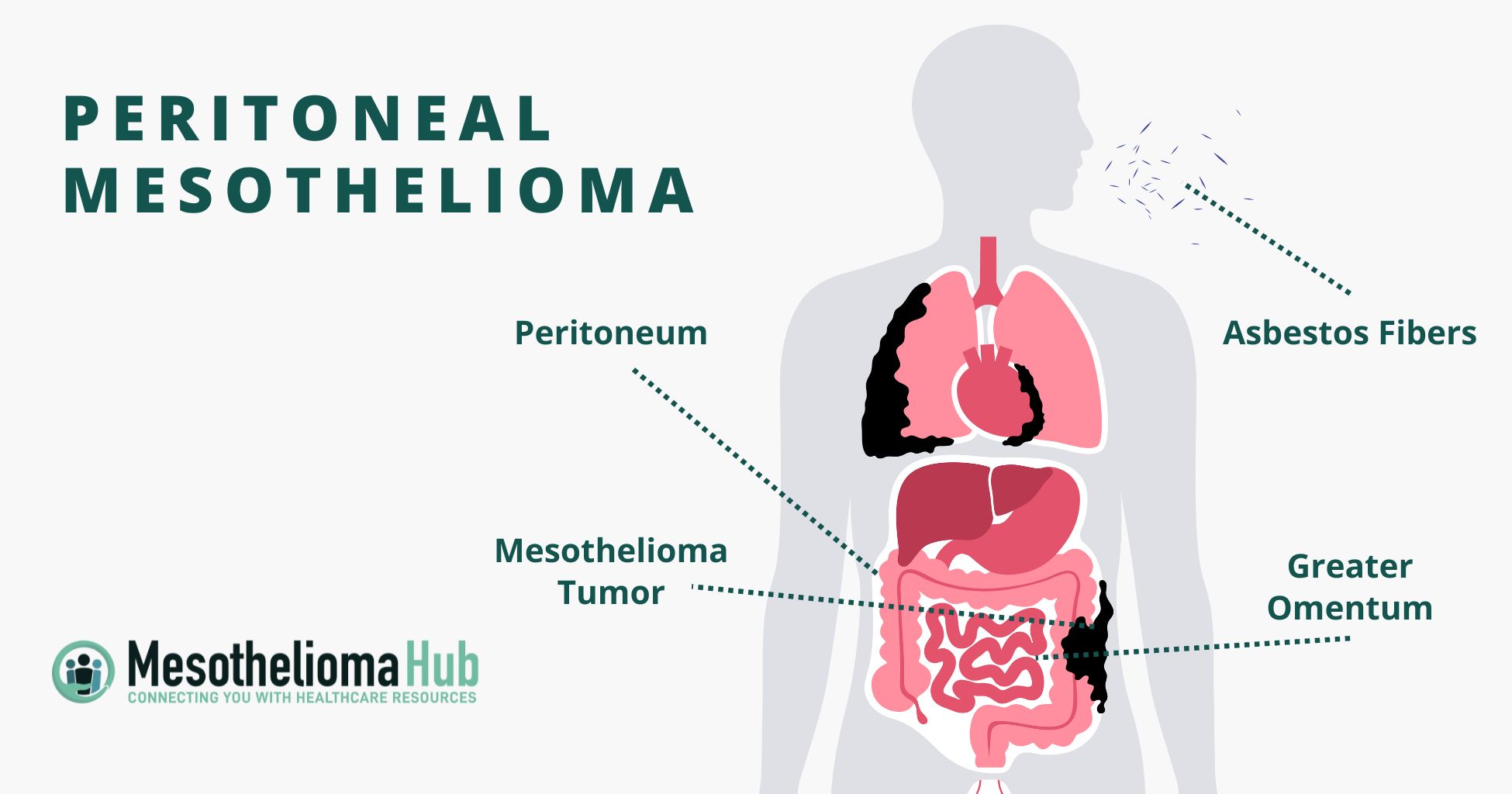Mesothelioma / Sites of Mesothelioma / Peritoneal Mesothelioma
What Is Peritoneal Mesothelioma?
Peritoneal mesothelioma affects the lining of the abdominal cavity (the peritoneum) and is the second most common type of mesothelioma diagnosed, although still rare. It is caused by exposure to asbestos if the mineral’s tiny fibers are ingested through breathing and swallowing. If enough asbestos powder makes it down the person’s stomach, the fibers may eventually cause enough damage in the abdominal region that tumors develop. Surgery and chemotherapy are often used to treat peritoneal mesothelioma. Usually, the two treatments go together.
Medically Reviewed by: Dr. Emma Hegwood, D.O | October 1st, 2024
Get Free Mesothelioma Guide

Peritoneal Mesothelioma
Peritoneal metastases refer to cancer that has spread to the peritoneum while cancers like peritoneal mesothelioma develop directly from the peritoneum itself. This cancer is a form of mesothelioma that develops in the abdomen, specifically on the peritoneum (the lining of the abdominal cavity). It is extremely rare, accounting for only about 20 percent of all mesothelioma cases annually, or about 660 cases per year in the United States. Patients with peritoneal mesothelioma may have a better prognosis than those with other types of mesothelioma. Typically, treatment involves a combination of chemotherapy and surgery.
How Is Peritoneal Mesothelioma Diagnosed?
All forms of mesothelioma take many years to manifest — sometimes upward of 50 years. The period between the original asbestos exposure and when symptoms appear is called the latency period. By the time symptoms begin to appear, the disease has likely advanced or begun to spread.
Generally, the diagnostic process \ starts with a series of imaging tests. For most, X-rays, CAT scans, and MRIs are common. If fluids are present in the abdomen, doctors may also take samples (paracentesis) for cytology or fluid biopsies. A tissue biopsy is often the last step in the process and is the only definitive way to diagnose the specific type of cancer. Biopsies are helpful for understanding what cell type is present in the tumor — important information when deciding on a treatment plan. Common biopsies used for diagnosing peritoneal mesothelioma include:
- Paracentesis
- A type of needle aspiration, paracentesis is used to attain a sample of the ascitic fluid from the abdomen. It also serves as a palliative treatment to relieve discomfort caused by the excess fluid buildup by removing large amounts of fluid.
- Diagnostic Laproscopy
- In this procedure, a camera is used to help doctors view inside the abdomen, identify which organs are affected, and take a diagnostic sample.
- Laparotomy
- During this surgical procedure, doctors try to remove as much of the tumor as possible. It also serves as a means to collect a sample for further diagnostic analysis.
What Causes Peritoneal Mesothelioma?
As with all forms of this cancer, exposure to asbestos is the only known cause of peritoneal mesothelioma. Asbestos — a cancer-causing mineral — has been used in a number of commercial and residential applications. When asbestos is disturbed, its microscopic fibers become airborne and can enter the body either through inhalation or ingestion.
While the disease affects both women and men, the method of exposure often differs. Men commonly face direct occupational exposure, whereas women tend to be exposed indirectly. Because asbestos fibers can travel for miles or be transported on the clothing, skin, or hair, indirect exposure is a threat for those living with people who are exposed to asbestos on the job. Interestingly, peritoneal mesothelioma has been more commonly associated with non-occupational exposure than the pleural form – which affects the lining of the lungs.
Symptoms of Peritoneal Mesothelioma
The most common symptoms of peritoneal mesothelioma are nonspecific abdominal pain, abdominal distension or swelling, lumps in the abdomen, and unexplained weight loss. Abdominal fluid buildup, or ascites, is commonly associated with peritoneal mesothelioma. In some cases, ascites can cause mild seizures as a result of accumulated toxins in the body. Additional symptoms include:
- Anemia
- Body aches
- Bowel obstruction
- Constipation
- Diarrhea
- Fatigue
- Fever or night sweats
- Hernia
- Nausea or vomiting
Similar to other types of cancer, the symptoms of peritoneal mesothelioma can mirror other conditions. Common misdiagnoses include:
- Colorectal adenocarcinoma
- Inguinal hernia
- Irritable bowel syndrome (IBS)
- Ovarian cancer
- Primary peritoneal carcinoma
- Stomach cancer
If you are experiencing any of the above symptoms, talk to your doctor right away. Be sure to inform your doctor if you may have been exposed to asbestos occupationally or perhaps indirectly from someone in your life who worked with or around asbestos.
Staging Peritoneal Mesothelioma
Since peritoneal mesothelioma is still a very rare condition, there is no formal staging system in place. Often, oncologists use the American Joint Committee on Cancer (AJCC) 1–4 staging scale to best determine the stage of mesothelioma. The Peritoneal Cancer Index (PCI) is also frequently used for assessing the extent of cancer present, as well as accounting for any spread to the lymph system or other parts of the body. The PCI score, a range from 0–39, helps determine eligibility for various treatments. A low score generally indicates minimal tumors or spread, equating to a stronger prognosis.
Is Peritoneal Mesothelioma Fatal?
That depends. Location, stage, cell type, patient age, and overall health all contribute to a patient’s prognosis. Due to the treatment options available, peritoneal mesothelioma tends to carry a better prognosis than other forms of this type of cancer (pleural or pericardial). Advances in treatment for peritoneal mesothelioma and other peritoneal metastases cancers have shown increased life expectancy among patients.
Know Your Cancer Treatment Options.
Download our guide to get the latest information about mesothelioma treatments, clinical trials, complementary and emerging therapies.
Download Guide
Surgery and Chemotherapy Treatment Options
The most common treatment plan for peritoneal mesothelioma is a peritonectomy. This procedure can be done with the intent to completely remove the cancer or to alleviate pain and discomfort, improving the patient’s quality of life, also known as palliative care. It combines cytoreductive surgery (surgery to remove all visible tumors and involved organs) with heated chemotherapy, sometimes called HIPEC (hyperthermic intraperitoneal chemotherapy).
In this procedure, the lining of the abdomen and all of the mesothelial tumors present in the abdomen are removed. The surgery is then followed by the administration of a heated chemotherapy wash to remove any remaining microscopic cancerous cells. Because the doctor can localize the chemotherapy drugs, reducing the negative impact on other parts of the body, HIPEC allows for a higher dose of chemotherapy to be applied directly to the affected organs.
Recent studies have shown that when these two treatments are combined, patients experience survival times between 52 and 92 months.
Specialists and Treatment Centers
- Dr. H. Richard Alexander, Jr. — Surgical oncologist and Chief Surgical Officer at Rutgers Cancer Institute of New Jersey in New Brunswick, New Jersey
- Dr. W. Charles Conway — Surgical oncologist at the Ridley-Tree Cancer Center in Santa Barbara, California
- Dr. James F. Pingpank Jr. — Oncologist at the UPMC Hillman Cancer Center in Pittsburgh, Pennsylvania
- Dr. Suzanne C. Schiffman — Surgical oncologist at the Allegheny General Hospital in Pittsburgh, Pennsylvania
- Dr. Paul H. Sugarbaker — Gastrointestinal oncologist at the Washington Cancer Institute in Washington, D.C.
Mesothelioma Support Team
Mesothelioma Hub is dedicated to helping you find information, support, and advice. Reach out any time!
